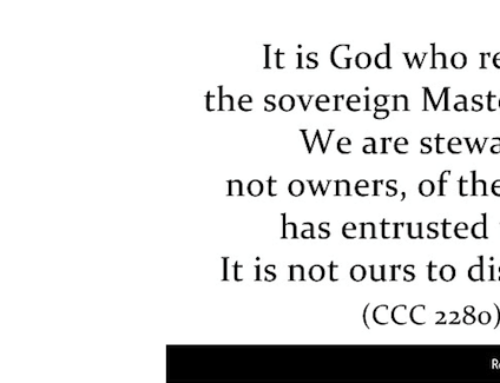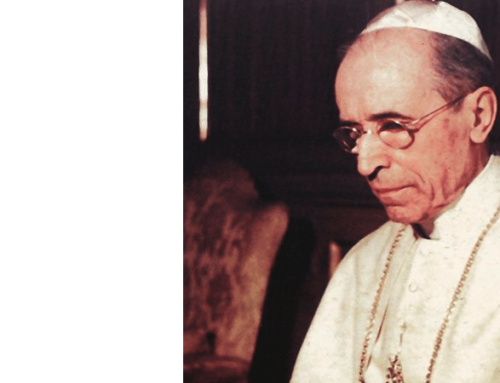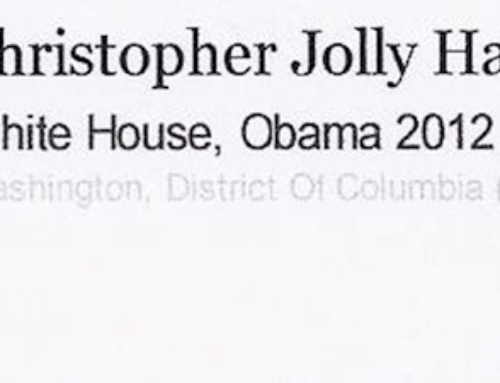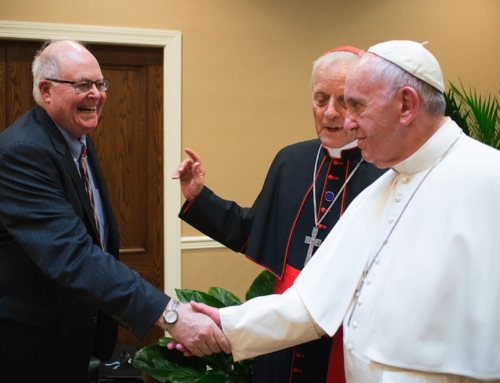by Robert P. Lockwood
(7/2000)
One of the striking points of anti-Catholicism in American culture – in addition to its persistence – is the sameness of it all. Down through the years, there is a tiresome repetition of old cliches about Catholics and Catholicism inherited from the Reformation in England. The difference in today’s popular anti-Catholicism is that the religious language has been stripped away, leaving the cliches to be re-stated from a secular focus. This allows today’s bigot to think that he is presenting some startling new thesis, when he is actually simply regurgitating canards hundreds of years old.
One such long-standing cliché of anti-Catholicism is to take contradictory swipes at the priesthood based on the practice of celibacy. On the one hand, it is argued that celibacy is the source of an unnatural prurience in Church teaching on sexual morality. Rather than being built on Scripture, natural law and a faith-based understanding of sexuality, the cliché argues that Catholic moral teaching comes from “old celibate males” who are anti-sex and concerned solely with imposing an unrealistic puritanical agenda. At the same time, however, all these old celibate males are portrayed as secretive sexual predators. Since celibacy is unnatural the anti-Catholic propagandist argues it can only lead to unnatural practices.
Such a self-contradicting attack on the priesthood was at the heart of 19th-century anti-Catholic literature, aptly described as “puritan pornography.” It is also the underlying assumption of the Kansas City Star series on AIDS in the priesthood, where it was argued that the unnatural requirement of celibacy attracts the sexually dysfunctional to the priesthood, leading to unsafe and secret sexual activity.
It is also at the heart of a new book by Mark D. Jordan, a former Catholic seminary instructor who teaches religion at Emory University. In The Silence of Sodom, Homosexuality in Modern Catholicism. (The University of Chicago Press, 2000) Jordan argues that, “the most important theological facts about Catholicism and homosexuality are not the bureaucratic words that Catholic authorities speak. The truly significant facts concern the homosexuality of the Catholic Church itself – of members of its priesthood and its clerical culture, of its rituals and spiritual traditions.” The Jordan argument is the old self-contradicting attack on the priesthood: the Church teaches against homosexual practices because it is at heart a clerical homosexual institution.
A self-described “openly gay man,” Jordan drafted his book while on a paid fellowship from the John S. Guggenheim Memorial Foundation. He also identifies himself as Catholic: “The Catholic tradition is my Christian tradition.”
In the first section of the book, Jordan simply dismisses recent Church statements on homosexuality as reminiscent of “European fascists of the 1920s and 1930s.” He purposely presents no arguments to which one can reply as he finds such efforts simply being lured into wasteful Church bureaucratic language and thinking. Instead, he revels in bombast. He describes the 1986 letter of the Congregation for the Doctrine of the Faith on the Pastoral Care of Homosexual Persons as filled with logic “by which the church could hand over or relax ‘sodomites’ to the secular arm for public execution.”
He similarly dismisses the 1998 U.S. Bishops’ statement, “Always our Children,” which was generally considered a moderate pastoral approach to parents of homosexual children. Jordan says that if the parents are strange enough to be disturbed by a child’s active homosexual lifestyle, the problem is caused by homophobic church indoctrination, not the lifestyle itself.
Jordan then arrives at his central thesis. He finds in Catholicism in general, and the priesthood in particular, a dominant “homoerotic” culture. It is central to liturgy, the sacraments, and the priesthood itself. Church teachings that condemn homosexual practices are vicious “efforts to keep the dreaded ‘secret’ from being spoken.” That secret, he argues endlessly but with no factual support, is that most priests are either active or closeted gays. “Catholic clerical arrangements…produce rich articulations of male-male desire, both because of compulsory priestly celibacy and because of the enormous development of all-male religious orders.”
It is an argument that would be familiar to 16th-century anti-Catholic propagandists and, in fact, Jordan cites reams of early hate literature that charged Catholic prelates, including popes, of engaging in homosexual activities. Though acknowledging that such charges were unfounded and most often grounded in political and theological agendas, such is unimportant to Jordan. “We need not consider the truth of papal sodomy, but it’s usefulness,” by which he means how useful it was as a charge against the Church. The whole Church was allegedly engaged in covering up the “secret” of a homosexual clergy. Such charges were therefore useful propaganda in undermining the Church in the eyes of the faithful. Truthfulness was never very important in the political or theological agenda. A similar agenda might be on Jordan’s mind today. In fact, he acknowledges that “my writing only fuels anti-Catholic bigotry” and that “it can always be used by anti-Catholics to confirm their view of the ‘whore of Babylon.’”
An old Catholic joke has a group of high school sophomores being told by their teacher that the average boy has a sexually related thought every 10 seconds. This shocks the boys, but one is more shocked than the rest. He asks: “What do they think about for the other nine seconds?”
Jordan’s book will remind the reader of that sophomoric sex-obsessed boy. He sees homoeroticism everywhere in Catholicism. The seminary, spiritual direction, the liturgy, church art and architecture, vestments, rectory life, religious education: all are expressions of a clerical culture “deeply colored by gay tastes and gay fantasies.” Though Catholics may want to define these things as part of living the faith, they are to Jordan “expressions of gay sensibilities…. the homosexuality of the Catholic ruling class.” In his more offensive chapter, he describes clerical life as “gay camp” and speaks of “priests who don’t think they are doing anything odd when they dress up in silks on Sunday morning to promenade, sing, act, and host a meal.” He describes the sacramental act of consecration of the Eucharist as a homosexual fantasy of creating the Perfect Male. It is ugly stuff that speaks more of the path Jordan has taken in life and his own obsessions, rather than any kind of an honest view of the priesthood and the Catholic faith.
“The Silence of Sodom” stoops so low as to cite two classics of American anti-Catholicism in an allegedly legitimate academic work – Charles Chiniquy’s 19th-century Fifty Years in the Church of Rome, most recently published by Jack Chick’s rabidly anti-Catholic press; and The Awful Disclosures of Maria Monk, the 1835 classic soft-porn “nuns-in-sexual-slavery” fraud. Maria Monk’s revelations were seen as fraudulent when it was discovered by a Protestant journalist that the convent she claimed to have escaped from had no hidden rooms as she wrote about, nor did the convent resemble in any way her description of it. Jordan sees Maria’s story as having the value of a parable: just as she could not prove her story of “hidden rooms,” you will not find the “secret” of male gay actions in the priesthood because there is “no suite of inner rooms sheltering all gay clergy. There is no well-established rituals or sweeping histories or even enduring networks of supports.” Which might lead the unbiased reader to conclude that just as Maria’s story had no basis in fact, Jordan’s charges are built on his own sexual ideology rather than any real facts.
Jordan’s book is filled with the illogical argument that denial of his case proves his case. He states that “conservative” Catholics who are loyal to the teaching of the Church are closeted homosexuals. When a journalist charged without any substantiation that Pope Paul VI had engaged in homosexual activity, the papal denial was proof that the allegations must have been true. Priestly actions in the liturgy are “gay camp” and made even more so by priestly denial that they are anything of the sort. Rejecting his thesis of this immense Catholic homosexual culture is succumbing to denial of the “secret.” In one of the oddest arguments in the book, Jordan links the reported cases of pedophilia by priests as one proof of this alleged homosexual culture even though it is generally understood that pedophilia is a severe psychological disease that is not directly linked with homosexuality. Certainly gay activists would be terribly distraught at such a linkage.
In an interesting sidebar to that discussion, Jordan writes that he knew Rudy Kos, the infamous pedophile from the diocese of Dallas. Jordan says that Koss was a student in his class on scholastic philosophy at Holy Trinity Seminary in Dallas. “I was too preoccupied with my own fierce combat against desires for men. Like so many in Catholic education (emphasis added), I was simply incapable of helping anyone with homoerotic secrets.” Kos passed his course.
Jordan concludes with a call to gay and lesbian Catholics to consider alternative communities to live out their faith. “You must leave the Church,” he writes, “to become a Catholic.”
This is a book of opinion – outrageous opinion – based on little more than the author’s own fantasy life. He ascribes to Catholicism, the Catholic priesthood, and the Catholic Mass itself a homoeroticism that exists solely in his own mind. From its cliched assumptions, through its bigoted citations, and to its conclusion that people should leave the Catholic Church at once, the book is an exercise in anti-Catholicism.
I do not fault Jordan so much for the tired prejudices that come from his difficult life. One can’t help wondering, however, about the motives of The University of Chicago Press for publishing such a profoundly anti-Catholic book, and the John S. Guggenheim Memorial Foundation for funding the author’s fantasy life.








